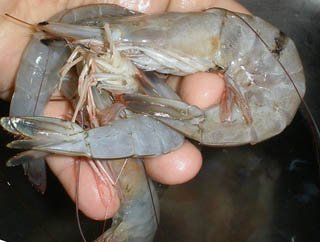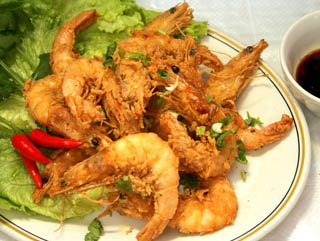Shrimp Nutrition facts
Shrimps, which are ten-legged crustaceans, can be discovered in both freshwater and saltwater environments across the globe. When these crustaceans grow to a larger size, they are commonly referred to as prawns. The succulent tail meat of shrimps, known for its delectable and versatile texture, stands as one of the most highly coveted seafood options in today's culinary landscape.
Scientifically, they are classified under the scientific name Penaeidae monodon, with the Giant Tiger Shrimp being a prominent member of the Penaeidae family.
 |
| Common Shrimp -fresh catch. Photo credit: Tony Alter. |
Habitat
The common shrimp is a diminutive crustacean that inhabits cold-water environments. These shrimps possess semi-transparent, grey-hued bodies and typically reach a length of approximately 2 inches. They thrive in shallow waters with soft sandy bottoms, and they exhibit a natural inclination to emerge during the nighttime, adopting a darker camouflage to facilitate their predatory activities.
Interestingly, when shrimps are exposed to cooking, they undergo a transformation, turning into a brownish-grey color.
Description:
Shrimps are slender, small-bodied crustaceans characterized by their spined, elongated cylindrical bodies and long tails, enabling them to move backward.
They exhibit a wide range of colors, depending on their subspecies, spanning from olive green to red.
Common shrimp, also known as pink shrimp or pink prawns, thrives in cold waters and can reach up to 10 cm (4 inches) in length. Abundant in the deep waters of the Mediterranean and Atlantic, related species are found globally. These prawns are highly regarded by the French and Italians for their exceptional flavor and vibrant red hue when cooked.
Deep red prawns: They inhabit the depths of the North Sea. They possess translucent pink bodies that transform into a pale salmon shade when cooked. Typically available precooked, they offer a delicate, juicy flavor.
Mediterranean prawn: These sizable cold-water prawns have the potential to reach lengths of up to 20 cm (8 inches). They go by the names blue or red shrimp, and their coloration can vary significantly-their heads can range from blood-red to deep coral, but when subjected to cooking, they transform into a striking red hue. Their flesh is not only delicious but also incredibly juicy.
Gulf shrimp: Hailing from the warm waters of the Gulf of Mexico, these prawns typically boast a bright red appearance, although they may occasionally exhibit a grayish-pink tint. They can attain a weight of up to 40 grams and offer succulent, tender flesh.
Japanese prawn: Also known as the kuruma shrimp (Marsupenaeus japonicus), these substantial warm-water prawns can grow as long as 23 cm (9 inches). Their bodies feature a pale color with brown bands running across their backs. They are prevalent throughout the Indo-Pacific region and can be found in the Red Sea.
Tiger prawn: Recognized as king prawns or jumbo shrimp in the United States, tiger prawns belong to the category of large warm-water prawns distributed across the Indo-Pacific region. They can reach impressive lengths of up to 33 cm (13 inches) and are exceptionally suited for barbecuing and grilling (broiling). In their raw state, they often appear translucent with a greenish-grey tint.
Health benefits of Shrimp
Shrimp, a type of crustacean, is known for its low-calorie content. Just 100g of its tail meat contains a mere 71 calories. Furthermore, its white meat is exceptionally low in fat, with only 1.01g per 3 oz (100g) serving.
Notably, shrimp's lean, non-oily white meat is an excellent source of protein. 100g of shrimp meat provides 13.61g (37% of the Daily Recommended Intake) of complete protein, containing all essential amino acids in healthy proportions.
Numerous research studies suggest that consuming seafood can reduce the risk of heart attack, stroke, obesity, and hypertension. Seafood is low in saturated fat and rich in "heart-healthy" polyunsaturated fats, including omega-3 fatty acids.
The American Heart Association recommends seafood consumption, including crustaceans, to meet the body's requirements for essential fatty acids, protein, minerals, and fat-soluble vitamins.
Shrimp also offers notable nutritional benefits, with 180 IU (6% of the Daily Intake values) of vitamin A and moderate concentrations of long-chain omega-3 fatty acids (PUFA).
Both vitamin A and omega-3 fatty acids are crucial for maintaining healthy hair, mucous membranes, and skin.
Shrimp primarily feed on small fish, mollusks, insects, and zooplankton, which happen to be excellent sources of B-complex vitamins. Shrimp meat is a good source of folates, niacin, vitamin B6, thiamin, and riboflavin.
Being at the bottom of the food chain, invertebrates like shrimp tend to accumulate very small amounts of heavy metals like mercury. The Food and Drug Administration (FDA) recommends that pregnant women consume at least 8 to 12 ounces (340 grams) of a variety of seafood with low mercury levels per week.
Shrimp is also rich in minerals, including phosphorus (35% of the Recommended Daily Intake), iron (3% of the Recommended Daily Intake), zinc (9% of the Recommended Daily Intake), selenium, iodine, calcium, potassium, and magnesium.
| Principle | Nutrient Value | Percent of RDA |
|---|---|---|
| Energy | 71 Kcal | 3.5% |
| Carbohydrates | 0.91 g | 0.7% |
| Protein | 13.61 g | 24% |
| Total Fat | 1.01 g | 5% |
| Cholesterol | 126 mg | 42% |
| Dietary Fiber | 0 g | 0% |
| Vitamins | ||
| Folates | 19 μg | 4% |
| Niacin | 1.778 mg | 11% |
| Pyridoxine | 0.161 mg | 12% |
| Riboflavin | 0.015 mg | 1% |
| Thiamin | 0.02 mg | 1.6% |
| Vitamin-A | 180 IU | 6% |
| Vitamin-C | 0 mg | 0% | Electrolytes |
| Sodium | 566 mg | 37.7% |
| Potassium | 133 mg | 3% |
| Minerals | ||
| Calcium | 54 mg | 5.4% |
| Iron | 0.21 mg | 3% |
| Magnesium | 22 mg | 4.5% |
| Phosphorus | 244 mg | 35% |
| Zinc | 0.97 mg | 9% |
| Omega-3 fats | ||
| EPA (20:5 n-3) | 0.068 g | -- |
| DPA (22:5 n-3) | 0.006 g | -- |
| DHA (22:6 n-3) | 0.07 g | -- |
Buying
Shrimps come in various forms and sizes for purchase, including whole or headless, fresh or frozen, cooked or smoked, shelled or unshelled. They can also be found in dried or canned variations. Notably, the larger shrimp tend to be more expensive.
When it comes to labeling, shrimps are often categorized as small, medium, large, extra-large, or jumbo, but the precise definitions of these terms can vary. It's advisable to select based on the shrimp count per pound, such as 16/20, indicating there are 16 to 20 shrimps per pound.
For fresh shrimp, opt for those that are firm-bodied and emit a subtle sea scent. When choosing frozen shrimp, ensure they have no frost or signs of drying.
Steer clear of shrimp that feels soft or slimy, ones where the body has separated from the shell, or those with an ammonia-like odor or black spots.
Storage
Shrimp are quite delicate and can either be frozen with a protective layer of ice on the fishing boat or cooked immediately. They can be stored in the following ways:
In the refrigerator for 1-2 days.
In the freezer for up to 1 month.
For optimal results, it's recommended to defrost shrimp slowly in the fridge.
Preparation
When working with whole shrimp, begin by removing the shell. Hold the head in one hand and the body in the other, then pull to detach the head along with the shell. Any remaining shell fragments on the body can be removed. For headless shrimp, you can use scissors to cut the shell before removal. Shelling slightly frozen shrimp is easier than handling unfrozen ones.
Keep in mind that 2 pounds of unshelled shrimp will yield approximately 1 pound of cooked meat, as there is typically a 50% wastage for whole, raw, unshelled shrimp.
The shrimp shells are excellent for making stock, which can enhance the flavor of your shrimp dishes. To prepare the stock, cover the shells with boiling water and simmer for 10 minutes, then strain the liquid before using it to cook the shrimp. Alternatively, you can grind uncooked shells and add them to butter for added flavor.
While some people prefer to eat shrimp with their intestines intact, you can devein shrimp by making a small slice into the flesh parallel to the dark vein and then removing it.
When cooking shrimp, be cautious not to overcook them, as this can make them tough and dry.
Here are some serving ideas:
The cardinal rule with any prawn or shrimp is not to overcook them, as this makes them tough and chewy. Ready-cooked prawns are best eaten without any further cooking.
 |
| Deep fried shrimp. Photo credit: Amy Nguyen. |
Shrimp can be enjoyed both hot and cold and are versatile as hors d'oeuvres, appetizers, or main dishes. They can be served on their own or paired with meat, poultry, vegetables, or pasta.
Shrimp can be used in soups, sauces, stuffings, and salads, often substituting for other crustaceans in recipes. In Southeast Asian cuisine, fermented shrimp in paste or powder form is utilized as a seasoning.
Serve shrimp simply with mayonnaise, lemon wedges, brown bread, and butter, or incorporate them into salads or prawn cocktails.
If you choose to cook shrimp, consider using them in dishes like pasta sauces, where they only need to be heated through.
Shrimp can complement other seafood dishes, such as fish pies, terrines, flans, and pair well with other shellfish.
Small prawns and shrimp are ideal fillings for omelets, bouchees, and tartlets.
Red prawns can be briefly boiled in saltwater or court bouillon and are delicious grilled, barbecued, or deep-fried in batter.
When combined with squid and other fish, deep-fried prawns are essential in Italian fritto misto.
Briefly frying prawns in butter and olive oil makes a superb warm salad when combined with scallops.
Warm water prawns are excellent for stir-fries, curries, and kebabs. Try chopping and mixing them with garlic, fresh ginger, and fresh cilantro.
They also make a delicious filling for steamed wontons.
Both prawns and shrimp can be used to make sauces to accompany fish dishes. A classic sauce crevette a l'anglaise is a rich butter sauce with added cooked, peeled shrimp. Adding shrimp butter to a creamy, cider-flavored sauce can elevate any plain fish dish.
Shrimp paste, a fermented condiment, is commonly used in curries, sauces, and sambal in various Southeast Asian cuisines.
Safety profile
Crustacean allergies can manifest in approximately 1% of the population and tend to be more prevalent during adolescence and adulthood, rather than in early childhood.
Most allergic responses to seafood are characterized by mild symptoms such as hives (urticaria), tingling sensations in the throat and mouth, swelling (angioedema), and gastrointestinal reactions like vomiting and diarrhea.
Also read ≻≻-
≺≺ Crawfish nutrition facts and health benefits.
≺≺ Anchovies nutrition facts and health benefits.
≺≺ Back to Seafood from shrimp nutrition facts and health benefits.
≺≺ Back to Home page.
Further reading (Links opens in new window):
Omega-3 Fatty Acids: An Essential Contribution.